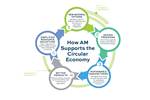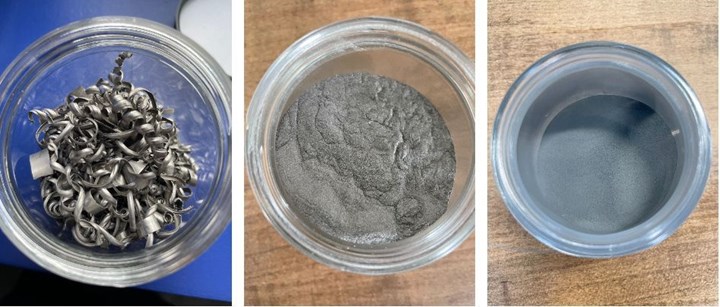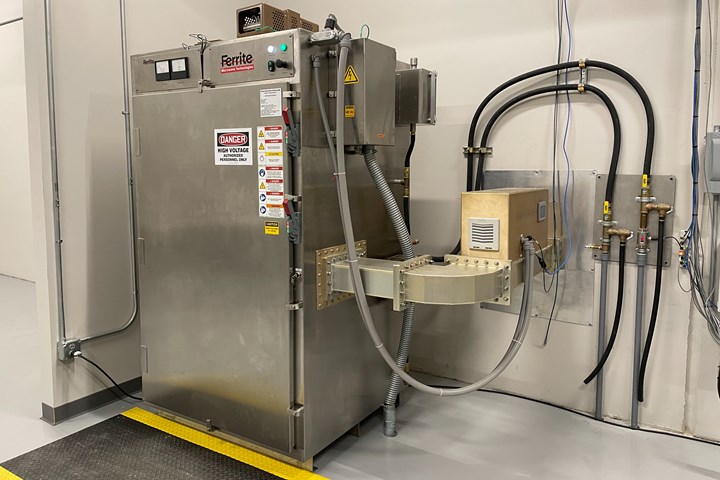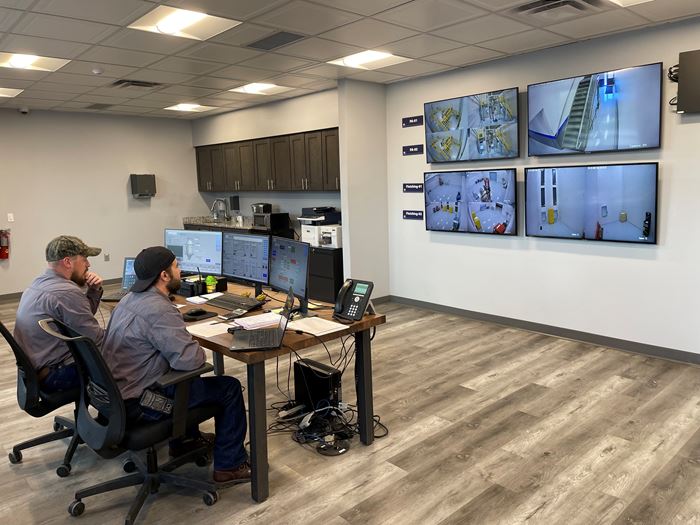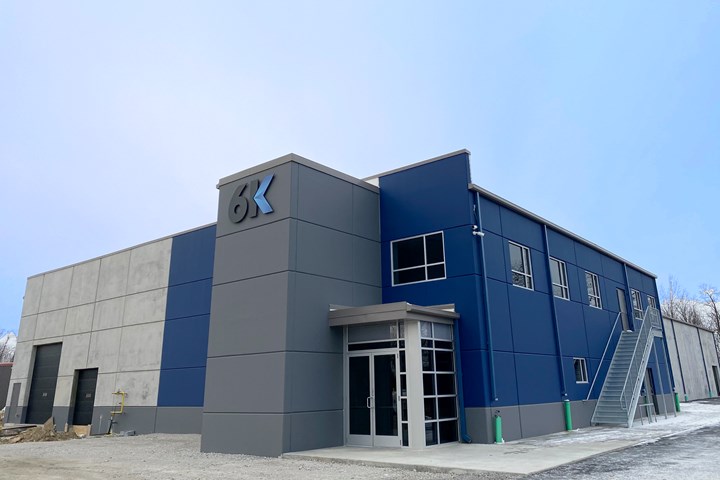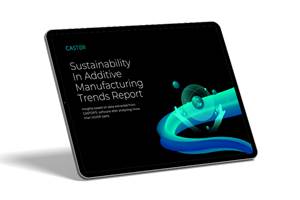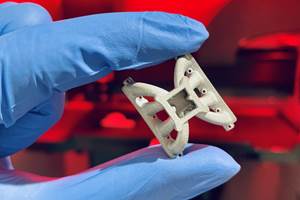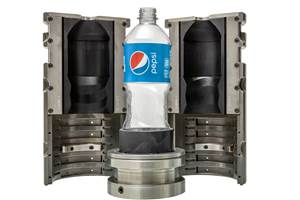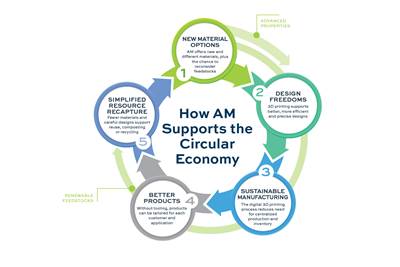The manufacturing world has come to recognize the promise of waste savings from additive manufacturing (AM). 3D printing makes a material-efficient part, and the benefits continue downstream. Lighter weight components contribute to energy savings and fuel efficiencies; a reduced part count with less need for fasteners reduces complexity and assembly, simplifying recycling; and the advance of distributed manufacturing brings the capability for local, on-demand production. All of these factors add up to a means of manufacturing with the potential to be more flexible and sustainable than conventional processes.
But for that potential to be realized, AM’s waste savings need to start at the beginning. The entire value chain needs to be interrogated, all the way back to the raw material. Powder metal provider 6K Additive points out that if the manufacturing process begins with virgin titanium alloy powder, then the sustainability benefits of the 3D printed part all come at a cost. The carbon footprint of producing and shipping new titanium powder can be significant. Along with various other metal alloys, most of the stock of titanium comes from China; the U.S. has no domestic source for mining it, and therefore has no choice but to import. And once the raw material is obtained, it must be processed, formed, mixed, melted and likely atomized to arrive at a fine metal powder usable for 3D printing — all steps that consume energy, require transportation, and increase the environmental impact of the feedstock before it even reaches the printer.
But imagine another way. While raw titanium may not be readily available in North America, there are various industries that currently mill, turn, grind or otherwise process this material into finished components. And millions of titanium parts made this way are installed in systems that become obsolete or require repair. What if instead of 3D printing parts from virgin titanium, it was possible to use this existing material? To avoid importing when it comes to AM material, and simply use the excess, waste, and inventory already here? The result would be a sustainable, circular cycle for metals — as well as a way of shoring up supply chains with more localized sources of these materials.
This is the scenario that 6K Additive is working toward. The powder producer has established a production facility in Burgettstown, Pennsylvania, where it uses mechanical milling and a proprietary microwave plasma technology to create powders for metal AM from the chips resulting from machining, from oversized powder, from condensate, from scrap parts and more. The microwave plasma technology is key, 6K says. With this, the process can begin with mechanically ground feedstock, and provide more precise control over powder size and morphology than gas atomization. The promise is less waste, energy savings in production and perhaps also on-site, local material recycling for metal part producers.
From Additive to Additive Manufacturing
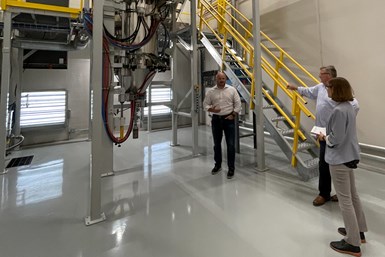
6K Additive president Frank Roberts (left) and chief marketing officer Bruce Bradshaw describe to me how the UniMelt reactor works. The Burgettstown location currently operates two of these microwave plasma reactors, one for nonreactive (nickel-based) and one for reactive (titanium and aluminum) alloys, but more are on the way.
6K Additive’s roots are in titanium recapture, but as an additive for metal casting. Frank Roberts, 6K Additive president, founded AL Solutions and developed technology to reclaim, clean and process titanium scrap into wrapped briquettes. Each about the size of a hockey puck, the briquettes can be dosed into the aluminum casting process to improve the latter material’s properties.
In May of 2019, AL Solutions was acquired by 6K, a producer of metals, ceramics, battery materials and more, and transformed into 6K Additive. Operating as a standalone business unit under its new parent, 6K Additive has been able to merge its material processing expertise with 6K’s UniMelt, the plasma microwave technology for synthesizing, spheroidizing and densifying powder materials. (The company’s name derives from 6,000 degrees Kelvin, approximately the operating temperature of the UniMelt process — and the temperature at the surface of the sun.)
“6K had the UniMelt technology, but we brought our experience handling volatile materials in a unique way, and a manufacturing mindset,” Roberts says.
The same process developed to clean and mill titanium for briquetting is now used to recapture titanium, nickel, refractory metals and more; once milled to size, the powder can be passed through a UniMelt reactor to spheroidize and densify it, producing reclaimed material suitable for additive manufacturing.
6K Additive’s goal is “ultimate flexibility” in terms of feedstock, Roberts says. The company can utilize scrap material like these turnings (left) by first cleaning and milling them to size (center), before the UniMelt process transforms the particles into powder suitable for additive manufacturing (right).
Making Metal Powder Using Microwave Plasma
The milled powder is only briefly melted inside the reactor, so the real key to the UniMelt process may be everything that happens leading up to the microwave plasma step. Unlike gas atomization which starts with melting solid blocks, pucks or pellets of metal, UniMelt requires metal powder as its input. This might be unused or recycled powder from laser powder bed fusion (LPBF); condensate collected from LPBF; oversized powder from atomization; metal chips from machining processes; even scrap parts.
In any case, the material must first be cleaned and milled down to the desired size before going into the UniMelt reactor to be refined. First a probe enters the reactor chamber (“the metal fork in the microwave,” Roberts calls it) to create a ball of stable plasma. Gas elongates the plasma into a cylinder about 18 inches long. Then, two injectors shoot the milled feedstock into the chamber, where argon disperses the particles as they fall through the plasma column. The material cools quickly enough that the resulting powder can be collected almost instantly. Each pre-milled grain that goes through the process remains distinct, so that the plasma step is only shaping and densifying each particle. The resulting powder is free from porosity and satellites, aiding its flow, spreadability and ultimately printability.
Safety and Automation at 6K
Efficiency Is the Key to Sustainability
The 6K Additive process promises new life for metal stock that otherwise would have been discarded, destroyed or simply forgotten. For titanium, it offers an alternative to mining and sourcing overseas as a starting point for metal powder. Instead, manufacturers can harvest and continuously recycle the titanium found in AM facilities, chip bins and aircraft boneyards here in the United States.
The product of that harvesting then can almost all be used for printing. Where powder production more typically produces a range of particle sizes that must be sieved and sorted into appropriate lots, UniMelt produces only one powder grade at a time. The ratio between output and input is therefore nearly one-to-one, Roberts says, which means that practically all the material that goes into a reactor emerges as product usable for AM. Tantalum, for example, has a poor input-output ratio with conventional gas atomization for AM powder production, 6K says; perhaps just 20% of what is produced in a melt cycle is usable for 3D printing. With the UniMelt process, it is possible to achieve near 100% output even for exotic materials like this.

Regardless of the feedstock, the goal is always to deliver a premium product, says Roberts. For 6K Additive that means powder that is spherical, dense and without satellites. The company believes its technology delivers these results while using less gas and energy than other processes.
Toward the Future
6K Additive broke ground on its Burgettstown, Pennsylvania, site in 2019, and it took just 10 months to build out the infrastructure to produce powder within spec. Its two reactors are currently running at about 50% capacity, and that figure is increasing as part of the ramp-up. The company is advancing toward 24/7 powder production, with three new nickel reactors set to be added by the end of 2021. At scale, each reactor will process about 100 tons of powder annually.
The 45-acre plot offers plenty of room for future physical expansion, too. This location will soon house all of 6K Additive’s powder operation, transitioning some of this capacity from West Virginia and consolidating feedstock sizing with spheroidization. A new analytical lab was coming online when I visited in August, bringing material characterization in house as well — capability that will become increasingly important as 6K Additive expands its portfolio of materials. The company launched with nickel 718 and 625, and now processes 316 stainless steel, tungsten and several grades of titanium. More materials are on the way, possibly including metal matrix composites (MMCs) or even battery materials as a complement to its 6K Energy sister company.
6K Additive broke ground on its Burgettstown facility in 2019, and was up and running in about 10 months. There is still plenty left to do at the 45-acre site as production ramps up. Photo: 6K Additive
But perhaps most significantly of all, it's possible a site like Burgettstown won’t be the only place to find a UniMelt reactor in the future. The company hopes to sell the units to key customers who might wish to recirculate metal materials closer to home. “This technology is the enabler to more holistic, sustainable manufacturing,” Roberts says.
Part of the remaining challenge with realizing this model for metal sourcing will be addressed by education, says 6K chief marketing officer Bruce Bradshaw. That is, helping manufacturers see the worth embedded in the chips, grindings or unusable powder that might otherwise be wasted. “People want to know, ‘Can you really take machining scraps?’” Bradshaw says. “They don’t realize the value they have. We’re a home for it.”
Related Content
Castor Publishes Sustainability in Additive Manufacturing Trends Report
New research from Castor indicates manufacturers can reduce tons of carbon emissions with 3D printing.
Read MoreEvaluating the Printability and Mechanical Properties of LFAM Regrind
A study conducted by SABIC and Local Motors identified potential for the reuse of scrap reinforced polymer from large-format additive manufacturing. As this method increases in popularity, sustainable practices for recycling excess materials is a burgeoning concern.
Read MoreIncus Successfully Tests Lithography-Based Metal Manufacturing for Lunar Environment
The project aim was to develop a sustainable process that uses lunar resources and recycled scrap metals (eventually contaminated by lunar dust) to produce spare parts on-site which could help and enhance human settlement on the moon.
Read MoreHow Hybrid Tooling — Part 3D Printed, Part Metal Shell — Accelerates Product Development and Sustainability for PepsiCo
The consumer products giant used to wait weeks and spend thousands on each iteration of a prototype blow mold. Now, new blow molds are available in days and cost just a few hundred dollars.
Read MoreRead Next
Can the U.S. Become Self-Sufficient in Aerospace Alloy Metal Powders?
6K’s technology can upcycle titanium and nickel-alloy parts into additive manufacturing powder. Here is how the circular economy helps national security.
Read MoreHow Is Additive Manufacturing Sustainable? AM Radio #2B
Additive manufacturing is often closely associated with sustainability, but why? And how can companies use AM to develop sustainable processes? Stephanie Hendrixson and Julia Hider discuss in this episode of AM Radio.
Read More4 Ways the Education and Training Challenge Is Different for Additive Manufacturing
The advance of additive manufacturing means we need more professionals educated in AM technology.
Read More

.jpg;width=70;height=70;mode=crop)

